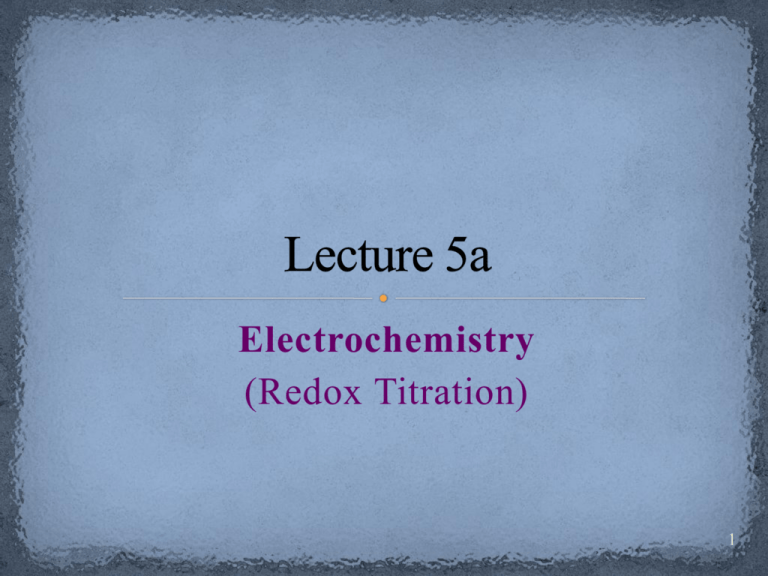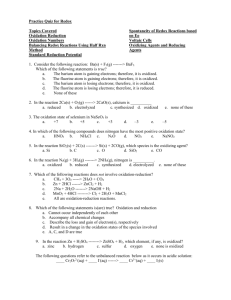Chem+14CL–Lecture+5a..
advertisement

Electrochemistry (Redox Titration) 1 Midterm: Monday, May 5, 2014 from 11:00 am – 11:55 am in CS 50, NO MAKE UP EXAM. The midterm is a closed book exam. No lab notebooks, no lab manuals, no lecture materials or other materials are allowed. If you are with OSD, make sure to inform them early enough so that they have room for you. The midterm will include the following topics: Amino acids: titrations, equivalence point, pH-values, error analysis (review post-labs; pre-labs and lecture guide) Spectrophotometry: calibration curve, determination of concentration Extraction: solubility, distribution coefficient, drying agent Infrared spectroscopy: interpret infrared spectrum, understand vibrational motions, degree of unsaturation and what it means, etc. (tables will not be provided) Mass spectrometry (tables will not be provided) UV-Vis spectroscopy: theory, Beer’s Law Electrochemistry: balancing redox equation, stoichiometric calculations Suggested materials to study practice problems: lecture guides, pre-lab study questions, text readings, lab procedures and reports, practice problems in supplemental course reader Bring the following items to the midterm: a scientific calculator (non-graphing!), blue or black pen/pencil 2 This week in lab: The student will perform the Vitamin C experiment The procedure is summarized in a handout that was emailed to the class two weeks ago (also posted online) The project requires two lab periods. The vitamin C experiment is an individual work and report. 3 Redox reactions primarily involve the transfer of electrons between two chemical species These reactions are very common in everyday life as well i.e., combustion, corrosion, batteries, biological processes, etc. The compound that loses one or more electrons is said to be oxidized, the one that gains one or more electrons is said to be reduced. OIL = RIG = Oxidation Is Loss (of electrons) Reduction Is Gain (of electrons) Each reaction by itself is called a half-reaction, simply because two half-reactions are required to describe a complete redox reaction If we consider this half-reaction (oxidation): Cu(s) Cu2+(aq) + 2 e This half-reaction expresses that solid copper (with no charge) is oxidized by losing two electrons to form a copper ion (+II). 4 The balanced equation has one copper atom on both sides and the charges are balanced as well (zero on both sides) The symbol “e-” represents a free electron with a negative charge that is released by this half reaction (reduction). It can reduce other species in the system i.e., Ag+-ion: 2 Ag+(aq) + 2 e2 Ag(s) Here, two silver ions (+I) are being reduced through the addition of two electrons to form solid silver. We can now combine the two half-reactions to form a redox equation: Cu(s) Cu2+(aq) + 2 e2 Ag+(aq) + 2 e2 Ag(s) Cu(s) + 2 Ag+(aq) + 2 e2 Ag(s) + Cu2+(aq) + 2 eAfter canceling the electrons on both sides, one obtains: Cu(s) + 2 Ag+(aq) 2 Ag(s) + Cu2+(aq) Experimental observation: the colorless silver solution turns blue due to the solved Cu(II)-ions 5 A compound that is oxidized itself is referred to as a reducing agent, while a compound that is reduced is referred to as the oxidizing agent. In another way: 2+ 2- If a compound causes another substance to be oxidized, it is called the oxidizing agent. In the equation above, Ag+(aq) is the oxidizing agent because it causes Cu(s) to lose electrons. The oxidants is reduced in the reaction with the reducing agent. Cu(s) is the reducing agent in this case as it causes Ag+(aq) to gain electrons. 6 Here are the steps to follow to balance a redox equation in acidic medium (add the steps with an asterisk are added in a basic medium): 1. Divide the equation into an oxidation half-reaction and a reduction half-reaction 2. For each half-reaction, Balance all elements except H and O Balance the O by adding H2O Balance the H by adding H+ Balance the charges by adding electrons (e-) 3. Multiply each half-reaction by an integer such that the number of electrons lost in one half-reaction equals the number of electrons gained in the other half reaction so that they cancel after addition 4. Combine the half-reactions and cancel identical species. 5. *Add OH- to each side until all H+ are consumed and then cancel again* 7 In considering redox reactions, one must know the oxidation numbers (ON) of the elements in the compound: an increase in oxidation number corresponds to an oxidation and a decrease to a reduction. The rules to determine oxidation numbers are shown below. Go through them in the order given until you have an oxidation number assigned. 1. For atoms in their elemental form, the oxidation number is ON=0. 2. For monoatomic ions, the oxidation number is equal to their charge i.e., Na+ is ON= +1, S2- is ON= -2. 3. For hydrogen atoms, the number is usually ON= +1 but in some cases (i.e., hydrides), it is ON= -1 4. For oxygen, the number is usually ON= -2 (except peroxide, O22- in which ON= -1) 5. Many metal ions can assume several oxidation states i.e., for Mn: 0, +2, +3, +4, +7 are common. However, alkali metals and alkaline earth metals are always +1 or +2, respectively. 6. The sum of the oxidation number of all the atoms in the molecule or ion is equal to its total charge i.e., KMnO4: K= +1, Mn= +7, 4 O= 4(-2 )= -8 8 The reaction of permanganate ions with iron(II) ions yields iron(III) ions and manganese(II) in acidic solution MnO4-(aq) + Fe2+(aq) What are the half reactions? Reduction: MnO4-(aq) Oxidation: Fe2+(aq) Fe3+(aq) + Mn2+(aq) Mn2+(aq) Fe3+(aq) What's the oxidation state of Mn in MnO4-? Let's balance the reduction half-reaction MnO4-(aq) Mn2+(aq) + 4 H2O(l) – the oxygen atoms are balanced MnO4-(aq) + 8 H+ Mn2+(aq) + 4 H2O(l) – the hydrogen atoms are balanced Balance the charges by adding electrons on the left side MnO4-(aq) + 8 H+ + 5 e- Balanced the oxidation reaction Fe2+(aq) Mn2+(aq) + 4 H2O(l) Fe3+(aq) + 1 e9 Multiply the oxidation reaction by five to balance the number of electrons being produced Add the two half-reactions together. Final answer: 5 Fe2+(aq) + MnO4-(aq)+ 8 H+ 5 Fe3+(aq) + Mn2+(aq) + 4 H2O(l) The specie, which gains electrons, is reduced (reduces its oxidation number) and is called the oxidizing agent. The specie, which loses electrons, is oxidized (increases its oxidation number) and is called the reducing agent. 10 Example II: An iron nail is dropped into a solution of copper sulfate. The nail gets coated with copper metal and the solution changes the color to very pale blue. Write the reaction that takes place, and the redox equation. Which atom was reduced and which one was oxidized? Answer Fe(s) + CuSO4 FeSO4 + Cu(s) Fe(s) + Cu2+(aq) + SO42-(aq) Fe2+(aq) + SO42-(aq) + Cu(s) The sulfate ion (SO42-) is unchanged in the equation, so has not been oxidized or reduced, which makes it a spectator ion Redox Reaction Fe(s) + Cu2+(aq) Fe2+(aq) + Cu(s) Iron donates two electrons to the Cu2+(aq) to form Cu (metal). The iron lost two electrons, so it was oxidized. The Cu2+(aq) gained two electrons, so it was reduced (in its oxidation number). 11 Example III: Pure zinc metal is placed into dilute hydrochloric acid. The metal dissolves and hydrogen gas (H2) is given off. Write the general equation and the redox equation. Which atom was reduced and which one was oxidized? Answer Zn(s) + HCl ZnCl2 + H2(g) Zn(s) + 2 H+(aq) + 2 Cl-(aq) Zn2+(aq) + 2 Cl- (aq) + H2(g) The chloride ion (Cl-) is unchanged in the equation, so it was oxidized or reduced, which makes it a spectator ion Redox Reaction Zn(s) + 2 H+(aq) Zn2+(aq) + H2(g) Zinc is oxidized to Zn2+(aq), H+(aq) is reduced to form H2(g) In General When there is oxidation, there is also reduction. The substance which loses electrons is oxidized. The substance which gains electrons is reduced. 12 Example IV: A student wants to determine the copper content of a piece of bronze, which is an alloy consisting of primarily of copper and tin. The student dissolves the sample in nitric acid and then adds a solution of potassium iodide. The reaction yields CuI and iodine, which is back-titrated using sodium thiosulfate Initial reaction Cu2+(aq) + I-(aq) + eCuI(s) 3 I-(aq) I3-(aq) + 2 e2 Cu2+(aq) + 5 I-(aq) 2 CuI(s) + I3-(aq) Back-titration 2 S2O32-(aq) + I3-(aq) 3 I-(aq) + S4O62-(aq) Overall The number of moles of thiosulfate is equivalent to the number of moles of copper in the sample. 13 Note that post lab report for vitamin C is individual report and is due on May 8 & May 9 depending on when your section meets. Vitamin C (compound I), also called ascorbic acid, is a colorless, water-soluble acid (Ka= 6.7 x 10-5, one of the enolic protons is lost) and also a powerful biochemical reducing agent that readily undergoes air oxidation to dehydroascorbic acid (compound II). (I) (II) 14 The spontaneous reaction that the students will study in this assignment involves the following two half reactions: 3 I- I3- + 2 e- Since both reactions involve two electrons, the stoichiometry between ascorbic acid and triiodide ion is 1:1. 15 The unknown sample, whether it is the amount of sodium thiosulfate in the solution or the vitamin C in a tablet is treated with a measured amount of iodate ion, IO3-, in an acidic solution containing an excess of iodide (I-). The red-brown triiodide ion (I3-), a milder oxidizing agent than IO3-, forms in acidic solution: IO3-(aq) + 8 I-(aq) + 6 H+(aq) 3 I3-(aq) + 3 H2O(l) (Eq. 1) The chemical analysis for the standardization of the sodium thiosulfate solution is summarized in the net ionic equation: IO3-(aq) + 6 S2O32-(aq) + 6 H+(aq) I-(aq) + 3 S4O62-(aq) + 3 H2O(l) (Eq. 2) Once the triiodide ion forms in (Eq. 1) it reacts with any ascorbic acid in solution to form dehydroascorbic acid: 16 The excess triiodide is titrated with standard sodium thiosulfate solution producing colorless iodide and tetrathionate ions (Eq. 4) 2 S2O32-(aq) + I3-(aq) 3 I-(aq) + S4O62-(aq) (Eq. 4) excess The difference in the amount of the triiodide generated from the iodate in Eq. 1 and the amount in excess that is titrated in (Eq. 4) is a measure of the ascorbic acid content of the sample. The endpoint of the titration can be determined by adding a quantity of starch solution to serve as an indicator just prior to the disappearance of the red-brown triiodide in the titration. Starch forms a tightly bound, deep blue ion with triiodide, [I3•starch]-, (Eq. 5). 3 I3-(aq) + 3 starch (aq) 3 [I3•starch]-(aq, deep-blue) (Eq.5) The addition of the S2O32- titrant is continued until the [I3•starch]- is reduced to I-, the solution appears colorless at the end point, (Eq. 6) 3 [I3•starch] - + 6 S2O32-(aq) 9 I-(aq) + 3 S4O6 2-(aq) + 3 starch(aq) (Eq. 6) 17 Experimental 1. Primary Standard: Potassium iodate (KIO3) The reaction with iodide generates a known amount of triiodide 2. Secondary Standard: Sodium thiosulfate (Na2S2O3) The titration of the triiodide solution with the sodium thiosulfate solution allows to determine the concentration of the Na2S2O3 solution 3. Analysis: Titrimetric Analysis of Vitamin C The reaction of triiodide with vitamin C leads to the consumption of some of the triiodide solution The back titration of the triiodide solution allows to determine the amount of unreacted triiodide, thus the amount of vitamin C in the sample 4. Indicator: Fresh starch solution Starch forms a dark-blue solution in the presence of triiodide Can detect as low as 2*10-6 M iodine 18





